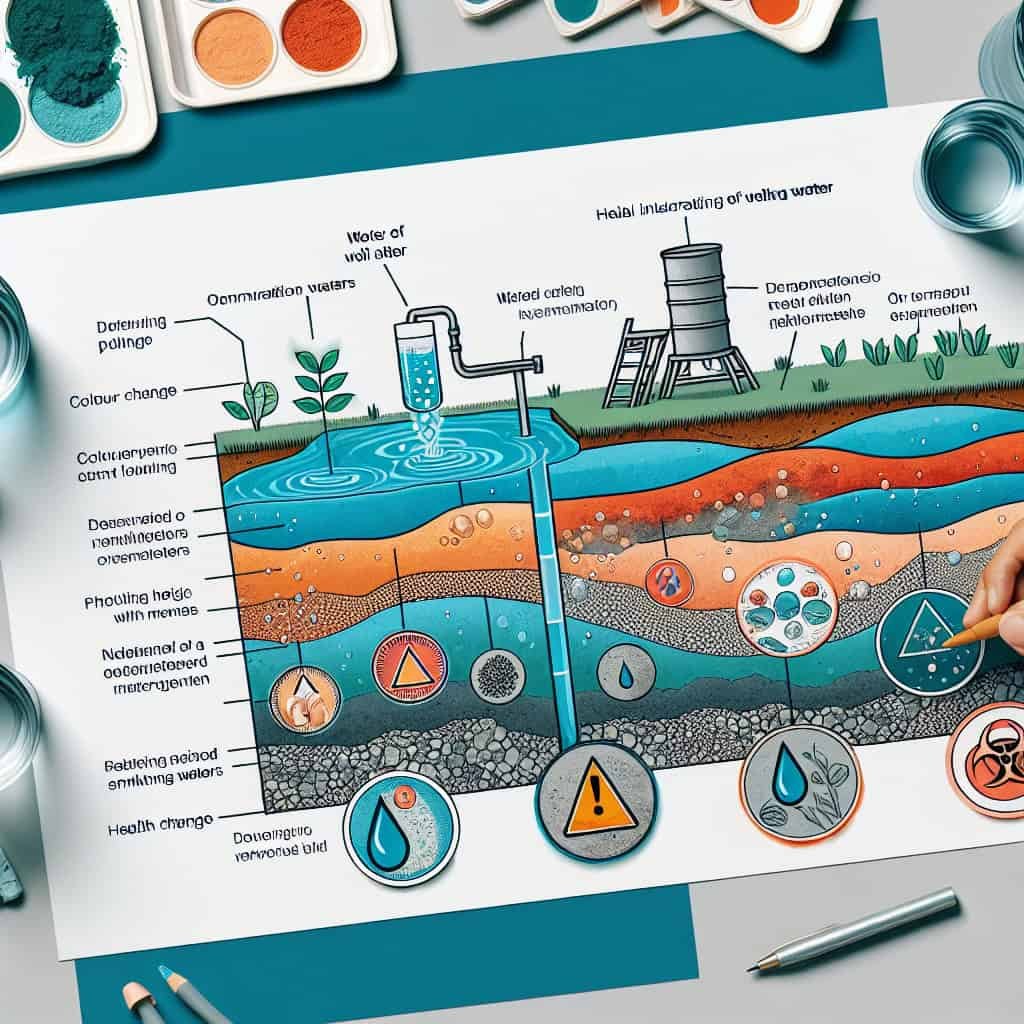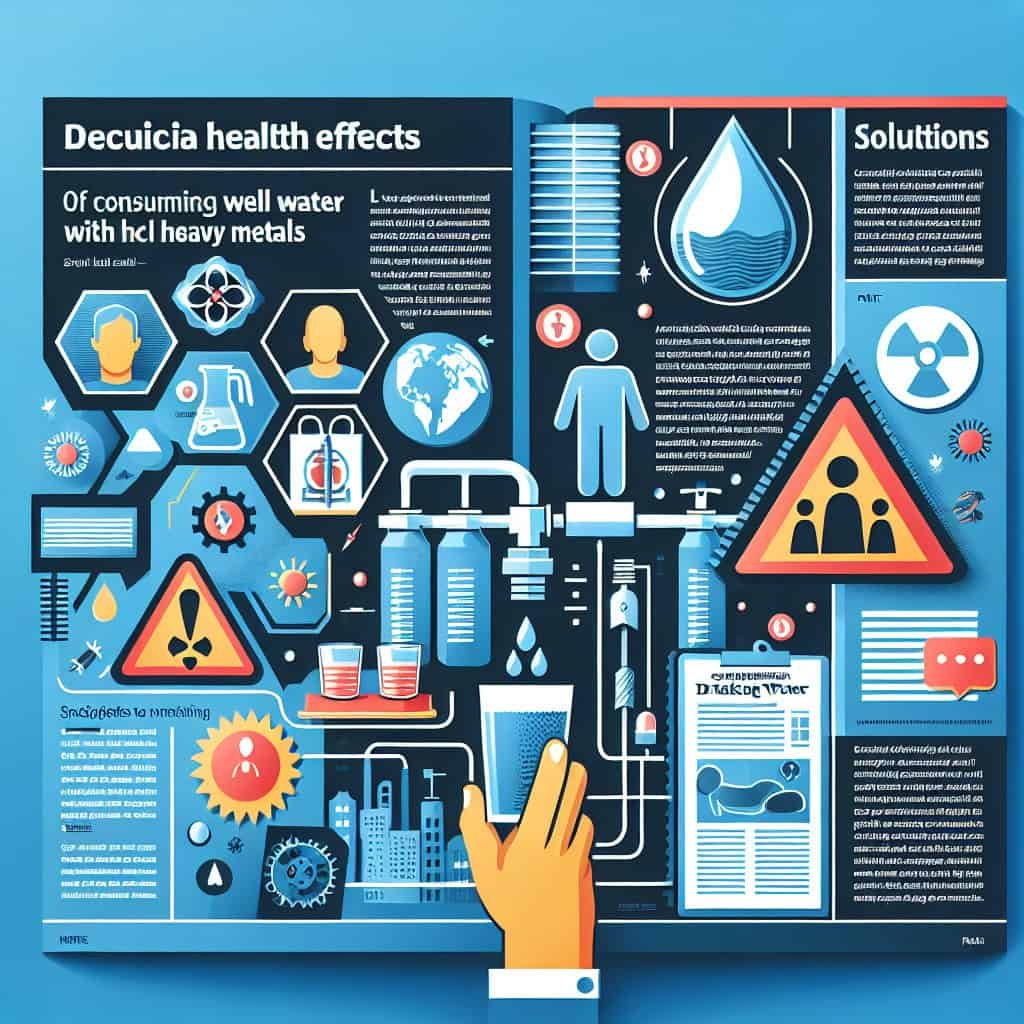You may be concerned about the quality of your well water if you suspect it has high levels of heavy metals. In this article, we will explore the topic of well water contamination and whether there are any guidelines in place to address this issue. With a friendly approach, we aim to provide you with valuable information to help you understand the potential risks associated with heavy metals in well water and the steps you can take to ensure the safety of your drinking water.
Health Effects of Heavy Metals in Well Water
Heavy metals in well water can have detrimental effects on your health. The most common heavy metals found in well water include lead, arsenic, mercury, and cadmium. Let’s take a closer look at each of these heavy metals and the potential health risks they pose.
Lead
Lead is a toxic heavy metal that can cause significant health problems when present in well water. High levels of lead exposure can lead to developmental delays in children, kidney damage, and reproductive issues. It is especially dangerous for pregnant women, as it can affect the development of the fetus.
Arsenic
Arsenic is another toxic heavy metal commonly found in well water. Chronic exposure to arsenic has been linked to various health issues, including skin lesions, cardiovascular diseases, and certain types of cancer, such as bladder, lung, and skin cancer. The long-term effects of arsenic exposure can be severe and even life-threatening.
Mercury
Mercury contamination in well water can have serious health implications. Exposure to mercury can negatively impact the nervous system, leading to neurological disorders, impaired cognitive function, and developmental issues. It is particularly harmful to pregnant women and young children, as it can affect the development of the brain and nervous system.
Cadmium
Cadmium is a heavy metal that can cause significant harm when present in well water. Prolonged exposure to cadmium has been associated with kidney damage, lung cancer, and bone diseases, such as osteoporosis. It is important to minimize exposure to cadmium to prevent these adverse health effects.
Common Sources of Heavy Metals in Well Water
Understanding the sources of heavy metals in well water is crucial for effective prevention and treatment. Here are the most common sources of heavy metal contamination in well water:
Industrial Activities
Industrial activities, such as manufacturing and mining, can contribute to the presence of heavy metals in well water. Discharge from factories and industrial complexes can contaminate groundwater, leading to elevated levels of heavy metals in well water.
Mining Operations
Mining operations, especially those involving metal extraction, can release heavy metals into the surrounding environment. Mining activities can introduce heavy metals like lead, arsenic, and cadmium into groundwater, which can then find their way into well water.
Agricultural Practices
Certain agricultural practices, such as the use of fertilizers, pesticides, and animal waste, can contribute to heavy metal contamination in well water. These substances can enter the soil and leach into groundwater, ultimately affecting the quality of well water.
Natural Deposits
Natural deposits of heavy metals in the earth’s crust can also be a source of contamination in well water. Certain geological formations can contain higher concentrations of heavy metals, and when groundwater comes into contact with these deposits, it can become contaminated.

Regulatory Standards for Heavy Metals in Well Water
To ensure the safety of well water, regulatory standards and guidelines have been established by organizations like the Environmental Protection Agency (EPA) and the World Health Organization (WHO). These standards help determine the acceptable levels of heavy metals in well water. Let’s explore the regulations set forth by these organizations:
Environmental Protection Agency (EPA) Regulations
The EPA has established maximum contaminant levels (MCLs) for heavy metals in well water. These MCLs represent the highest allowable concentration of a substance in drinking water that is still considered safe for human consumption. For example, the MCL for lead is set at 0.015 milligrams per liter (mg/L), while the MCL for arsenic is 0.010 mg/L.
World Health Organization (WHO) Guidelines
The WHO also provides guidelines for heavy metals in well water. These guidelines aim to protect human health and provide a reference for countries to set their own standards. For instance, the WHO guideline value for lead is 0.01 mg/L, while the guideline value for mercury is 0.006 mg/L.
It is crucial to adhere to these regulatory standards and guidelines to ensure the safety of your well water.
Testing and Monitoring of Heavy Metals in Well Water
Regular testing and monitoring of well water can help identify the presence of heavy metals and ensure the quality of your drinking water. Here are some important aspects of testing and monitoring:
Sampling Techniques
Proper sampling techniques are crucial for accurate testing and monitoring of heavy metals in well water. Samples should be collected using clean containers and following specific protocols to prevent contamination. It is recommended to sample well water at different times throughout the year to account for seasonal variations.
Laboratory Analysis
Testing for heavy metals in well water should be conducted by accredited laboratories using appropriate analytical methods. These laboratories can provide detailed reports on the levels of heavy metals present in the water sample. If heavy metals exceed regulatory standards, appropriate actions can be taken to ensure the safety of the water.
Frequency of Testing
The frequency of testing and monitoring well water for heavy metals depends on various factors, including the presence of potential contamination sources and previous test results. It is generally recommended to conduct initial testing and then follow a regular schedule for future monitoring. This ensures that any changes in heavy metal levels are detected promptly.

Treatment Options for Well Water Contaminated with Heavy Metals
If your well water is contaminated with heavy metals, there are several treatment options available to ensure it is safe for consumption. Let’s explore some of the commonly used treatment methods:
Physical Filtration
Physical filtration involves the use of filters that physically trap and remove heavy metal contaminants from well water. This can include activated carbon filters, sediment filters, and multimedia filters. These filtration systems effectively remove heavy metals and provide clean, safe drinking water.
Chemical Treatment
Chemical treatment methods, such as coagulation and flocculation, can be effective in removing heavy metals from well water. Chemical agents are added to the water, which react with heavy metal ions and form larger particles that can be easily removed through sedimentation or filtration.
Reverse Osmosis
Reverse osmosis is a highly effective treatment method for removing heavy metals from well water. In this process, water is forced through a semi-permeable membrane, which selectively removes heavy metals, contaminants, and impurities. Reverse osmosis systems can provide high-quality water free from heavy metals.
Ion Exchange
Ion exchange involves the use of resin beds that selectively exchange heavy metal ions in well water with harmless ions. This process effectively removes heavy metals, ensuring the purity of drinking water. Ion exchange systems can be an excellent treatment option for heavy metal-contaminated well water.
Factors Affecting the Effectiveness of Heavy Metal Treatment Methods
Several factors can influence the effectiveness of treatment methods for heavy metal-contaminated well water. Understanding these factors is crucial for selecting the most appropriate treatment option. Let’s take a look at some of the key factors:
Concentration of Metal
The concentration of heavy metals in well water can impact the effectiveness of treatment methods. Higher concentrations may require more advanced treatment techniques or a combination of treatment methods to achieve satisfactory results.
pH Level
The pH level of well water can significantly affect the efficiency of heavy metal treatment methods. Some treatment methods work better under specific pH conditions. Adjusting the pH of the water can optimize the performance of treatment systems, ensuring effective removal of heavy metals.
Water Hardness
Water hardness, which is determined by the presence of calcium and magnesium ions, can influence the efficiency of treatment methods. High water hardness can interfere with the removal of heavy metals and may require additional treatment steps to ensure effective removal.

Potential Challenges in Treating Well Water with High Levels of Heavy Metals
Treating well water with high levels of heavy metals may pose certain challenges. It’s important to be aware of these challenges to ensure effective treatment. Here are some potential challenges:
High Treatment Costs
Treating well water contaminated with heavy metals can be costly, especially for high concentrations or large volumes of water. Advanced treatment methods, such as reverse osmosis or ion exchange, can require significant investments in equipment, maintenance, and operation.
Limited Accessibility to Treatment Technologies
In some areas, access to advanced treatment technologies for heavy metal removal may be limited. This can be due to factors like remoteness or lack of infrastructure. The availability of treatment options may vary depending on the location, making it challenging for some well owners to access suitable treatment methods.
Preventive Measures to Reduce Heavy Metals in Well Water
Prevention is key when it comes to reducing heavy metal contamination in well water. By following these preventive measures, you can minimize the risk of heavy metal exposure:
Avoiding Polluted Water Sources
Ensure that your well is constructed in an area away from potential sources of heavy metal contamination, such as industrial facilities, mining sites, or agricultural activities. Regularly inspect the surrounding area for possible pollution sources, and take steps to address any concerns.
Proper Waste Disposal
Dispose of hazardous materials, such as batteries, paint, and chemicals, properly and according to local regulations. Avoid dumping these substances in or near your well to prevent heavy metals from seeping into the groundwater.
Regular Maintenance of Wells
Maintaining your well is crucial for minimizing the risk of heavy metal contamination. Regularly inspect your well for any signs of damage or deterioration. Ensure that well caps are secure, and avoid storing hazardous materials near the well.

Health Risks and Drinking Water Guidelines for Heavy Metals
Understanding the health risks associated with heavy metals in well water is vital for protecting yourself and your family. Here are the health risks and recommended drinking water guidelines for some common heavy metals:
Lead
High levels of lead in drinking water can lead to developmental delays, kidney damage, and reproductive issues. The EPA has set the maximum contaminant level for lead in drinking water at 0.015 mg/L.
Arsenic
Chronic exposure to arsenic in drinking water can cause skin lesions, cardiovascular diseases, and various types of cancer. The EPA has set the maximum contaminant level for arsenic in drinking water at 0.010 mg/L.
Mercury
Mercury exposure in drinking water can have detrimental effects on the nervous system, leading to neurological disorders and impaired cognitive function. The EPA does not have a specific MCL for mercury, but it recommends a limit of 0.006 mg/L.
Cadmium
Cadmium exposure in drinking water can result in kidney damage, lung cancer, and bone diseases. The EPA does not have a specific MCL for cadmium, but it recommends a limit of 0.005 mg/L.
These guidelines serve as an important reference to ensure that well water is safe for consumption.
Health Monitoring and Public Awareness Programs
Regular health check-ups and public awareness programs play a crucial role in addressing the health risks associated with heavy metals in well water. Here’s why they are important:
Importance of Regular Health Check-ups
Regular health check-ups can help identify any adverse health effects caused by heavy metal exposure in well water. Monitoring the health of individuals exposed to heavy metals can allow for early detection and intervention, ensuring appropriate medical treatment is provided.
Education and Outreach Initiatives
Public awareness programs are essential for educating individuals on the risks associated with heavy metals in well water and promoting preventive measures. These initiatives can include community workshops, educational campaigns, and distribution of informational materials, all aimed at empowering individuals to take action to protect their well water and health.
By prioritizing health monitoring and implementing effective public awareness programs, we can collectively work towards minimizing the health risks associated with heavy metals in well water.
In conclusion, the presence of heavy metals in well water can have severe health consequences. Awareness of the sources, regulatory standards, testing methods, and treatment options is crucial for ensuring the safety of your well water. By taking preventive measures, monitoring your well water regularly, and participating in public awareness programs, you can protect yourself and your family from the health risks associated with heavy metals in well water.


